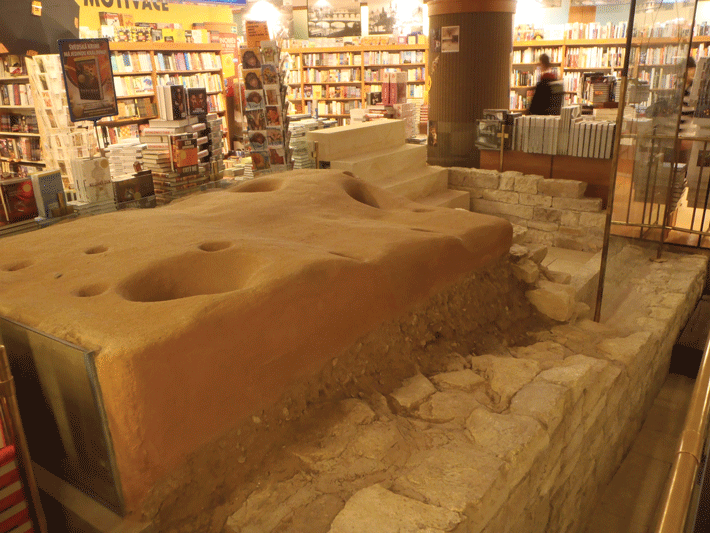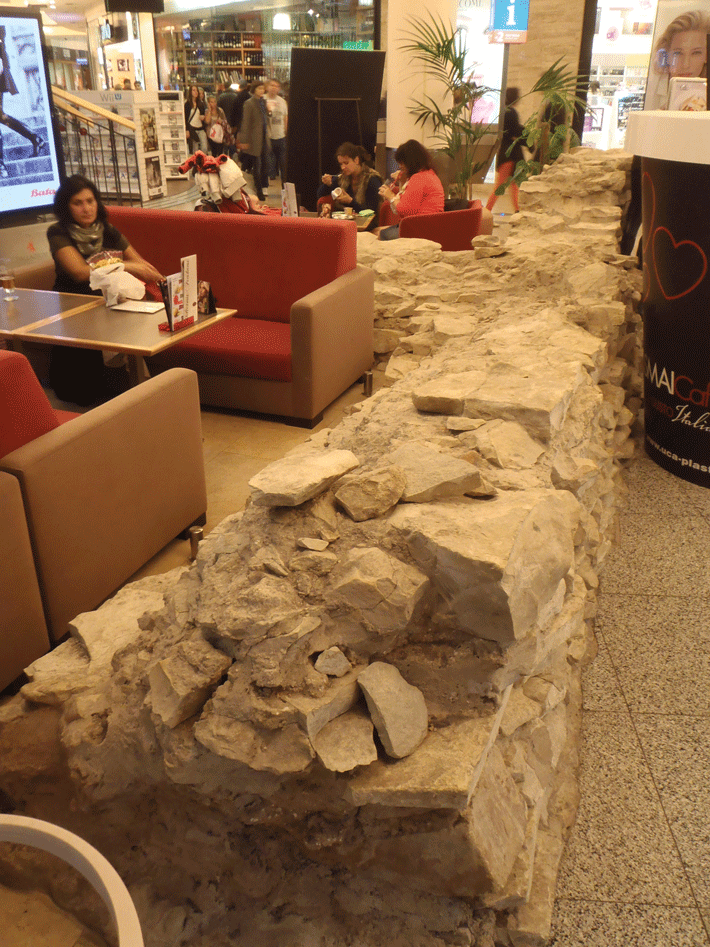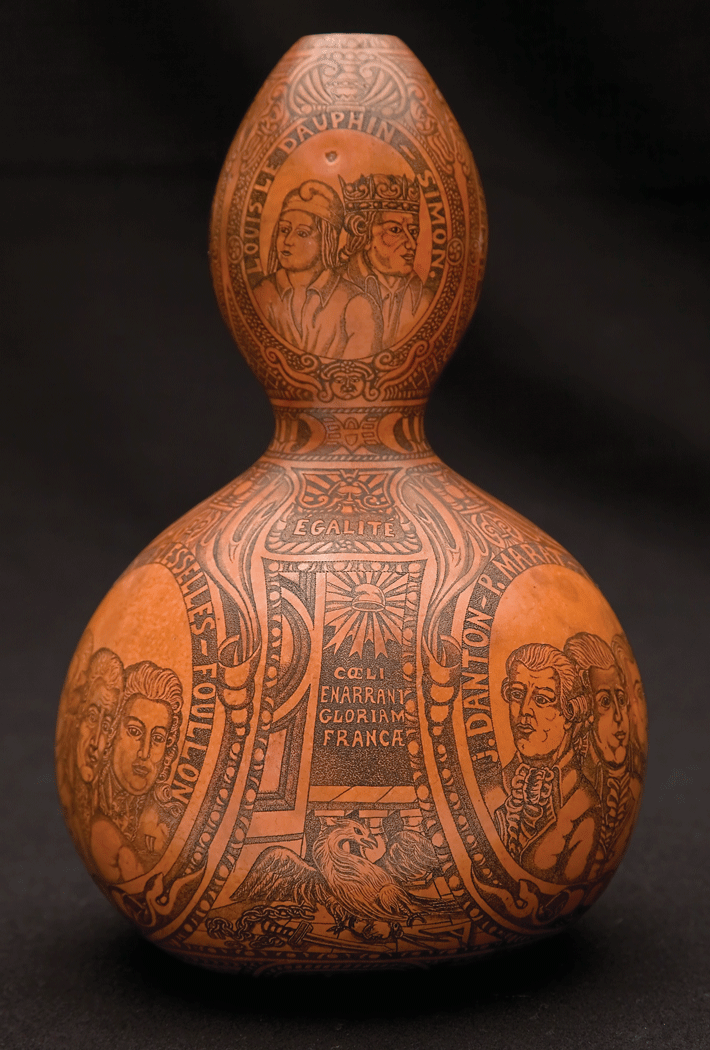From the Trenches
Ham Hill's Violent History
By JASON URBANUS
Tuesday, December 10, 2013
 Researchers have finished a three-year investigation into Ham Hill, Britain’s largest Iron Age hillfort. Located in Somerset, the site’s defensive walls stretch nearly three miles, enclosing an area of 220 acres. The settlement flourished throughout the first millennium B.C., but may have suffered a violent confrontation in the first or second century A.D. Gruesome evidence indicates that the remains of hundreds, if not thousands, of slaughtered and dismembered humans are buried on Ham Hill. The date of these burials, together with the discovery of Roman military equipment, suggests that Ham Hill was subject to a violent assault during the early stages of the Roman conquest of Britain.
Researchers have finished a three-year investigation into Ham Hill, Britain’s largest Iron Age hillfort. Located in Somerset, the site’s defensive walls stretch nearly three miles, enclosing an area of 220 acres. The settlement flourished throughout the first millennium B.C., but may have suffered a violent confrontation in the first or second century A.D. Gruesome evidence indicates that the remains of hundreds, if not thousands, of slaughtered and dismembered humans are buried on Ham Hill. The date of these burials, together with the discovery of Roman military equipment, suggests that Ham Hill was subject to a violent assault during the early stages of the Roman conquest of Britain.
Off the Grid
By MALIN GRUNBERG BANYASZ
Tuesday, December 10, 2013

There are three main sections of historic Prague in the Czech Republic: Old Town, Lesser Town, and New Town. King Charles IV, the Holy Roman Emperor who moved his capital to Prague, designed New Town himself in 1348 on farmland east and south of the original city. Construction of a new mall from 2003 to 2006, and the rescue excavations that were part of it, revealed that there was even more to historic Prague. East of Old Town, the archaeologists working on the city’s largest-ever dig uncovered the remains of yet another urban center outside Old Town, dating to 150 years before Charles IV’s burst of urban planning. According to archaeologist Pavel Titz of Charles University, this occupation outside Old Town had a “sometimes quite splendid urban character.”
 The site
The site
Prior to the construction of the Palladium, now the Czech Republic’s largest shopping center, archaeologists found the foundations of twelfth-century structures that predate the construction of Old Town’s city walls. The remains consist primarily of three Romanesque structures, including what Titz refers to as a “palace,” one of only three such buildings in Prague. It had many rooms and several stories, along with a well-preserved cesspit and bits of flat window glass, possibly the oldest in the city. The foundations of the buildings were constructed of timber and masonry, the first evidence in Prague of such an approach to construction. The digs also turned up more than five million pieces of pottery, animal bone, glass, and ceramics. Following the excavation, archaeologists and developers were faced with the challenge of how to preserve the important remains. A visit to the Neoluxor bookstore reveals the solution: Amid the shelves of books for sale are the actual foundation and walls of the “palace” building, along with Romanesque column bases. Stonework, artifact cases, and informational signage pop up throughout the shopping experience. “The Palladium shows that it is possible to preserve and present archaeology in modern buildings,” says Titz.
While you’re there
The Palladium has more than 200 shops and 30 restaurants and cafés, but the rest of historic Prague is right on its doorstep. No visitor can miss Prague Castle in Lesser Town, the largest castle complex in the world; the ornate Astronomical Clock on the facade of Old Town Hall; and bustling Wenceslas Square in New Town, in addition to countless museums, churches, Jewish monuments, and architectural wonders both old and new.
French Revolution Forgeries?
By NIKHIL SWAMINATHAN
Tuesday, December 10, 2013

When Louis XVI went to the guillotine on January 21, 1793, spectators dipped handkerchiefs in his blood as souvenirs of the French Revolution. One hanky reportedly ended up in a hollow gourd decorated with figures of the revolution, such as Maximilien de Robespierre and Jean-Paul Marat. Over the following 200 years the rag dissolved, leaving just a bloodstain, while the hollowed-out squash itself passed into the hands of an Italian family.
In 2009, the family enlisted paleogenomicist Carles Lalueza-Fox, of Barcelona’s Pompeu Fabra University, to verify that the blood in the gourd was in fact Louis XVI’s. Lalueza-Fox sought out a DNA sample from a member of the House of Bourbon, the royal lineage to which Louis XVI belonged, as a basis of comparison. In the process, he found himself in a genetic quandary that called into question the authenticity of not one, but two, purported relics of the French Revolution.
In the late 1990s, Jean-Jacques Cassiman, a forensic geneticist at Catholic University of Leuven in Belgium, had authenticated a preserved heart that reportedly belonged to Louis XVII, Louis XVI’s son who died at age 10. He did this by isolating mitochondrial DNA, which is passed from mother to child, from the heart and comparing it with genetic material from hair belonging to Louis XVII’s mother, Marie Antoinette. Lalueza-Fox asked Cassiman for a sample of Y-chromosome DNA, which is passed from father to son, to authenticate the gourd blood, but the Belgian team had been unable to extract any from the heart.
Advertisement
Advertisement
IN THIS ISSUE
From the Trenches
French Revolution Forgeries?
Off the Grid
Ham Hill's Violent History
Tracking the Ancient Apache
The Well-Dressed Dead
Lego Supports Slumping Mummy
Mississippian Burning
A Final Journey by Horse
Neanderthal Smorgasbord
Point-and-Shoot Obsidian Analysis
Idu: Lost City of Northern Iraq
Thorfinn the Mighty's Thing
The Doctor Is In
Artifact
Roman Britain's finest work
Advertisement

Recent Issues
-
 May/June 2024
May/June 2024
-
 March/April 2024
March/April 2024
-
 January/February 2024
January/February 2024
-
 November/December 2023
November/December 2023
-
 September/October 2023
September/October 2023
-
 July/August 2023
July/August 2023
-
 May/June 2023
May/June 2023
-
 March/April 2023
March/April 2023
-
 January/February 2023
January/February 2023
-
 November/December 2022
November/December 2022
-
 September/October 2022
September/October 2022
-
 July/August 2022
July/August 2022
-
 May/June 2022
May/June 2022
-
 March/April 2022
March/April 2022
-
 January/February 2022
January/February 2022
-
 November/December 2021
November/December 2021
-
 September/October 2021
September/October 2021
-
 July/August 2021
July/August 2021
-
 May/June 2021
May/June 2021
-
 March/April 2021
March/April 2021
-
 January/February 2021
January/February 2021
-
 November/December 2020
November/December 2020
-
 September/October 2020
September/October 2020
-
 July/August 2020
July/August 2020
-
 May/June 2020
May/June 2020
-
 March/April 2020
March/April 2020
-
 January/February 2020
January/February 2020
-
 November/December 2019
November/December 2019
-
 September/October 2019
September/October 2019
-
 July/August 2019
July/August 2019
-
 May/June 2019
May/June 2019
-
 March/April 2019
March/April 2019
-
 January/February 2019
January/February 2019
-
 November/December 2018
November/December 2018
-
 September/October 2018
September/October 2018
-
 July/August 2018
July/August 2018
-
 May/June 2018
May/June 2018
-
 March/April 2018
March/April 2018
-
 January/February 2018
January/February 2018
-
 November/December 2017
November/December 2017
-
 September/October 2017
September/October 2017
-
 July/August 2017
July/August 2017
-
 May/June 2017
May/June 2017
-
 March/April 2017
March/April 2017
-
 January/February 2017
January/February 2017
-
 November/December 2016
November/December 2016
-
 September/October 2016
September/October 2016
-
 July/August 2016
July/August 2016
-
 May/June 2016
May/June 2016
-
 March/April 2016
March/April 2016
-
 January/February 2016
January/February 2016
-
 November/December 2015
November/December 2015
-
 September/October 2015
September/October 2015
-
 July/August 2015
July/August 2015
-
 May/June 2015
May/June 2015
-
 March/April 2015
March/April 2015
-
 January/February 2015
January/February 2015
-
 November/December 2014
November/December 2014
-
 September/October 2014
September/October 2014
-
 July/August 2014
July/August 2014
-
 May/June 2014
May/June 2014
-
 March/April 2014
March/April 2014
-
 January/February 2014
January/February 2014
-
 November/December 2013
November/December 2013
-
 September/October 2013
September/October 2013
-
 July/August 2013
July/August 2013
-
 May/June 2013
May/June 2013
-
 March/April 2013
March/April 2013
-
 January/February 2013
January/February 2013
-
 November/December 2012
November/December 2012
-
 September/October 2012
September/October 2012
-
 July/August 2012
July/August 2012
-
 May/June 2012
May/June 2012
-
 March/April 2012
March/April 2012
-
 January/February 2012
January/February 2012
-
 November/December 2011
November/December 2011
-
 September/October 2011
September/October 2011
-
 July/August 2011
July/August 2011
-
 May/June 2011
May/June 2011
-
 March/April 2011
March/April 2011
-
 January/February 2011
January/February 2011
Advertisement






